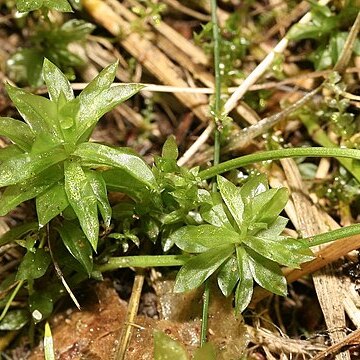Plants large to robust, solitary or gregarious, green above, reddish brown below; terricolous or humicolous. Stems erect from rhizomes, 10-50 mm tall, simple or occasionally branching by subperichaetial innovations, red-brown, tomentose; rhizoids reddish brown, densely papillose. Leaves distant and reduced below, rosulate above, erect and twisted dry, spreading to squarrose wet; spathulate or oblong-spathulate, 7-14 mm long; apex acute or occasionally obtuse; margins recurved to revolute in lower 3/4 to 2/3, denticulate to dentate above; border weak, 1-2(-3) cells wide. Costa short excurrent or occasionally ending below apex, tapering above; in section subround or semi-crescent shaped, ventrally flat to slightly concave, laminal insertion ventral, ventral cells in 4-6 rows, dorsal stereid band small, dorsal cells generally in 2 rows, hydroids present between stereid band and ventral cells. Upper laminal cells rhomboidal, (72-)85-112(-137) µm long, (25-)30-35 µm wide, frequently pitted; basal cells rectangular, frequently pitted. Filamentous gemmae absent. Dioicous, frequently polysetaceous. Perichaetia terminal; leaves lanceolate or triangular, margins entire to denticulate above, costa forming denticulate awn. Seta 27-42 mm tall, yellowish red or reddish brown; capsule pendulous, yellowish brown, oblong-cylindrical, slightly curved, slightly contracted below mouth dry, urn 2.5-5.0 mm long, neck short; exothecial cells irregular in shape, incrassate, smaller at mouth; peristome teeth narrowly oblong-acuminate, yellowish brown or orange, hyaline above, finely papillose, endostome segments keeled, tapered above, broadly perforated, cilia 2-3, appendiculate, basal membrane high, yellowish, minutely papillose; operculum conic, mammillate; spores round, 17-23 µm, minutely papillose.
More
Stems 1-3 cm, usually branched by slender subapical innovations. Stem leaves relatively few in rosettes, 18-22, 3-8 mm; margins revolute to mid leaf or less; apex acute; costa in median rosette leaves subpercurrent to percurrent or short-excurrent, apiculus or hair-point slender, in cross section stereid band small, not reaching dorsal epidermal layer, with at least one distinct intervening layer of thin-walled cells. Perichaetial inner leaves with costa subpercurrent, percurrent, or short-excurrent, hair-point smooth to weakly denticulate. Spores 16-20 µm.

